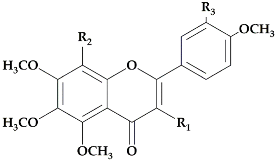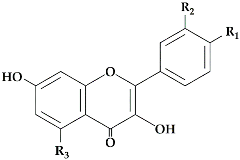3. Flavonoid Composition in Different Parts of Citrus Fruits
It has been found that
Citrus flavonoids are present in almost all the parts of
Citrus fruits in different species. Several studies showed that peels are the main sources of polyphenols in
Citrus fruits
[15][19]. Seed and peel extracts from numerous
Citrus species have proved to be an important source of flavonoids, such as polymethoxyflavones (PMFs), flavanones, and glycosylated flavanones
[16][20]. More than 5000 flavonoid molecules have been identified
[17][21].
Citrus juice is also a major source of flavanone glycosides. Moreover, the contents and types of flavonoids vary among different
Citrus species and fruit parts
[17][21]. Flavanones are the most important flavonoids in Citrus species. Hesperedin and naringenin are the predominant flavanones in Citrus fruits
[12][16]. They can be found in all plant parts: stem, branches, bark, flowers, leaves, roots, rhizomes, seeds, fruits, peels, etc. Flavones are the second major group of flavonoids in
Citrus, with flavonols in third place because their content is much lower than the other flavonoids
[13][14][17,18]. The content of these components depends upon the age of the plant; most
Citrus species accumulate substantial quantities of flavonoids during organ development. Another study showed that flavonoids content might be affected by the maturity of the fruit, the post-harvesting treatments and the extracting processes
[18][22]. Juice preparation and the processing of fresh
Citrus fruits may decrease flavonoids content by 50% due to their water washing methods
[19][20][23,24], or by elimination of the richest parts of the fruit
[21][25].
In this review, we gather some relevant data for the most abundant flavonoid component in sweet orange (
C. sinensis), sour orange (
C. aurantium), mandarin orange (
C. reticulata), clementine (
C. Clementina), lemon (
C. limon), and grapefruit (
C. Pardisi) juices and peel. It should be noted that
Citrus peel exhibit higher contents of flavanones than other parts of the fruit
[22][11]. Depending on their varieties, grapefruit and sour orange are very rich in naringin. Other
Citrus species such as sweet orange, and lemon have low quantities of naringin (
Table 23). Pupin et al.
[23][26] studied the composition of flavanone glycosides in various orange juice varieties and concluded that narirutin and hesperidin are the most abundant compounds. Hesperidin is present in high levels in clementine, sweet orange, mandarin orange and lemon (39.9–20.5 mg/100 mL juice), while naringin (23 mg/100 mL juice) and narirutin (7.6 mg/100 mL juice), glycosides of naringenin, are especially more abundant in grapefruit (
Table 23)
[24][27]. In lemon, eriocitrin is present in high level (16.17 mg/100 mL juice)
[23][26]. Didymin is a typical flavonoid glycoside also known as neoponcirin used in Asian countries as a dietary antioxidant
[25][28]. This flavonoid is mainly present in orange, mandarin and grapefruit (1.89–0.30 mg/100 mL juice) (
Table 23).
The most abundant flavanones in
Citrus peel are naringin andhesperidin. These flavanones are all glycosylated either by rutinose (6-O-
α-
l-rhamnosyl-
d-glucose) or by neohesperidose (2-O-
α-
l-rhamnosyl-
d-glucose) linked in position 7
[25][28]. Hesperidin (0.002 to 9.42 mg/g peel dry basis)
[26][27][29,30] is the main flavanone in all lemon cultivars while levels of diosmin and eriocitrin are the lowest
[28][31]. Mandarin peel is rich in hesperidin (3.95 to 80.90 mg/g peel dry basis)
[29][30][32,33], narirutin (7.66 to 15.3 mg/g peel dry basis)
[18][31]| - |
| 16.17 |
| 3.12 |
| 4.95 |
1.17 |
- |
- |
| Grapefruit |
0.93 |
7.60 |
23.0 |
0.3 |
0.41 |
- |
- |
- |
- |
- |






 Encyclopedia
Encyclopedia
